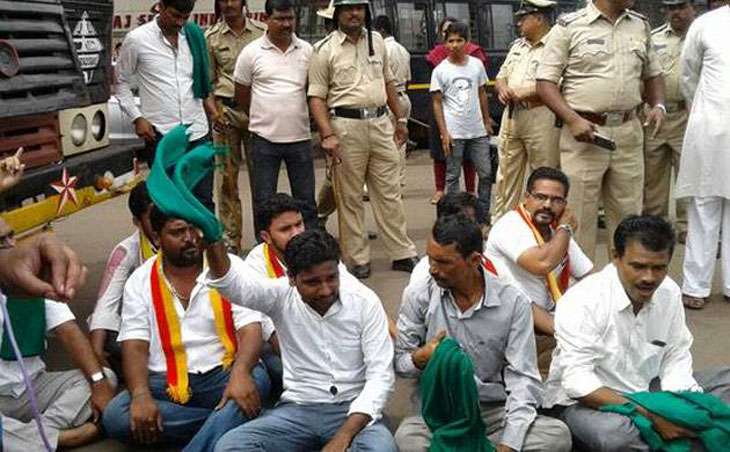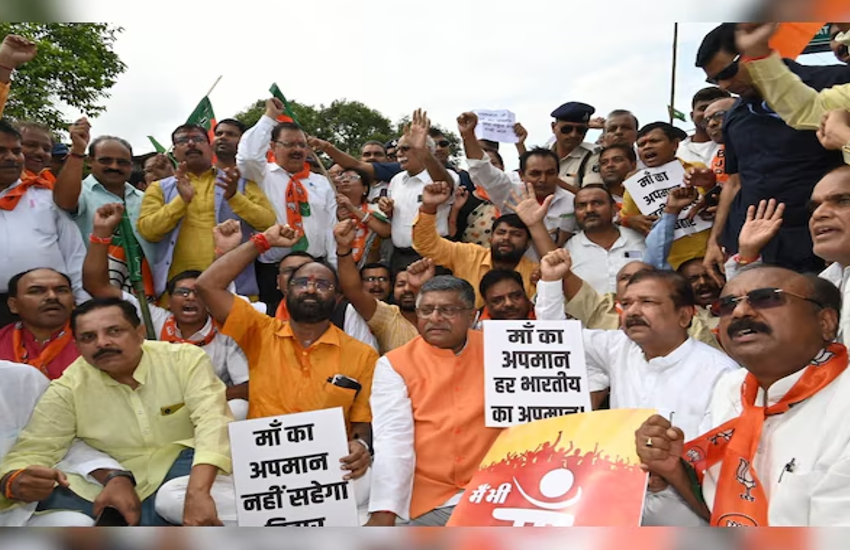SC order on Cauvery water sharing: Karnataka farmers hit the streets in protest

Protests have erupted in Karnataka over the Supreme Court-directed release of Cauvery waters to Tamil Nadu.
Since early Tuesday morning, hundreds of farmers have taken to the streets and blocked vehicular traffic between Bengaluru and Mysuru.
Some of them have even threatened to march to the Krishna Raja Sagar (KRS) dam to stop the release of water.
What happened this monsoon?

The perennial problem of sharing Cauvery waters between the two states surfaced once again after the apex court told Karnataka on Monday to release 15,000 cusecs of water (1.29 Tmcft, or a thousand million cubic feet) every day over the next 10 days.
The SC bench, comprising of Justices Dipak Misra and UU Lalit, had asked the two states to 'live and let live', while admitting Tamil Nadu's petition that its Samba paddy cultivation on 40,000 acres in the Cauvery region had been adversely affected due to lack of water.
The Cauvery supervisory committee, headed by the Union water resources secretary, has been asked to meet in three days and sort out issues.
Karnataka contends that with the failure of the monsoon, the state is faced with its worst water crisis in four decades, as nine out of its 11 major reservoirs have less than 40% storage of water.
The water level in the KRS is even more precarious, as it has only 17.50 Tmcft against the total capacity of 47 Tmcft, and it is unlikely to get any more inflow until next June.
The other smaller reservoirs of Kabini, Harangi and Hemavathy in the Cauvery basin also have low storages, as the Western Ghats and Kodagu, which normally feed them with bountiful supplies, received scanty rainfall this year, upsetting predictions of a 'normal' monsoon.
As the Cauvery is the major source of drinking water for Bengaluru, Mysuru, Ramanagara and other urban centres, the Karnataka government had notified the farmers in the Cauvery basin two weeks ago that water supplies would be stopped for farming from 31 August to conserve them for drinking over the next few months.
State water resources minister MB Patil said with a total of 49 Tmcft of water in the four reservoirs, it would be barely sufficient to meet the needs of Bengaluru and other towns, which account for a population of 140 lakh.
Farmers of Mandya and Maddur have already sown paddy and sugarcane on around 20,000 acres of land, while another 40,000 acres were ready for sowing. This is why they are upset with the government's decision. Farmers' groups are gearing up to start an agitation.
Minister Patil points out that as against scarcity in Karnataka, Tamil Nadu has received good rains this year, and there is a storage of 83.24 Tmcft in the Mettur dam, which it has locked up for future use.
Last, year around this time, there was an overflow from Mettur, and Tamil Nadu had to issue a flood warning to the farmers downstream.
Turbulent history
The River Cauvery has had a turbulent history over the last 200 years, as the then-Madras Presidency and the princely state of Mysore waged bitter fights for using its waters.
Though Cauvery takes birth in Talacauvery in Kodagu (then Coorg), and Karnataka is the upper riparian state, Kannadigas contend that the Tamils used the might of British Empire to suppress their rights for a long time, and enjoyed copious supplies of water for cultivation.
On the advice of then Diwan Sir M Visvesvaraya, when the Maharaja of Mysore laid the foundation for the KRS dam in 1911, the Madras Presidency complained to London, the work was stalled. The construction began only in 1924 after protracted negotiations and an agreement which permitted the state to impound water only after the river reached a certain level, that the state would irrigate only three lakh acres, that it would store no more than 45 Tmcft, that it would ensure two crops in the Madras province, that it would obtain permission of the neighbouring state before building any check dams to the tributaries of Cauvery, that there would be no restrictions on Madras building such check dams...
This one-sided agreement was supposed to lapse after 50 years, and renegotiations held as per section IX of the agreement. But Tamil Nadu maintains that this 1924 agreement, as well as the earlier 1892 agreement, "are valid and binding on Karnataka", a position which was upheld by the Cauvery Water Disputes Tribunal in 2007.
The tribunal, which was set up in 1991 and took 16 long years to deliver its judgement, failed to satisfactorily resolve the issue, which had four parties to the dispute - Tamil Nadu, Karnataka, Kerala and Puducherry. Its verdict did not satisfy either Karnataka or Tamil Nadu, mainly because the tribunal adopted a statistical approach, completely ignoring the vagaries of the monsoon.
The tribunal's 'final award' allocated 419 Tmcft of water to Tamil Nadu, 270 Tmcft to Karnataka, 30 Tmcft to Kerala and 7 Tmcft to Puducherry, on the basis of a total yield of 740 Tmcft in the Cauvery basin "in a normal year".
The difficulty arose because of the time-table put forward by the tribunal, mandating Karnataka to release 192 Tmcft of water in year, stipulating weekly releases. In the last two decades or so, 'normal years' have been erratic, and releases have almost always been less than quantified.
Karnataka is supposed to release 134 Tmcft between June and September, but this year, the yield in the Karnataka basin has been less than 90 Tmcft. Karnataka's constant plea that there should be a "distress formula" in the years of drought have so far been ignored, causing frequent clashes between the two states.
Experts' view ignored
Experts on either side have argued that there should be more scientific ways of preserving water during excess monsoon, instead of letting it drain out into the Arabian Sea. They also argue that the traditional ways of cultivation of flooding the fields should give way to better management of water resources, with the building of more check dams and anecuts in the lower regions.
But politicians, both in Karnataka and Tamil Nadu, revel in whipping up the emotions of people, rather than sitting across the table and sorting out issues. It needs statesmanship, which unfortunately, is lacking.
Edited by Shreyas Sharma
First published: 6 September 2016, 23:09 IST





![BJP's Kapil Mishra recreates Shankar Mahadevan’s ‘Breathless’ song to highlight Delhi pollution [WATCH] BJP's Kapil Mishra recreates Shankar Mahadevan’s ‘Breathless’ song to highlight Delhi pollution [WATCH]](https://images.catchnews.com/upload/2022/11/03/kapil-mishra_240884_300x172.png)

![Anupam Kher shares pictures of his toned body on 67th birthday [MUST SEE] Anupam Kher shares pictures of his toned body on 67th birthday [MUST SEE]](https://images.catchnews.com/upload/2022/03/07/Anupam_kher_231145_300x172.jpg)






